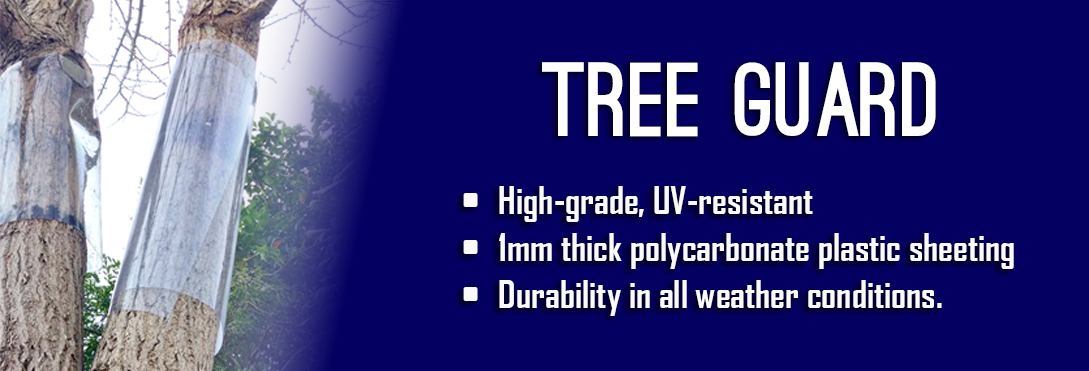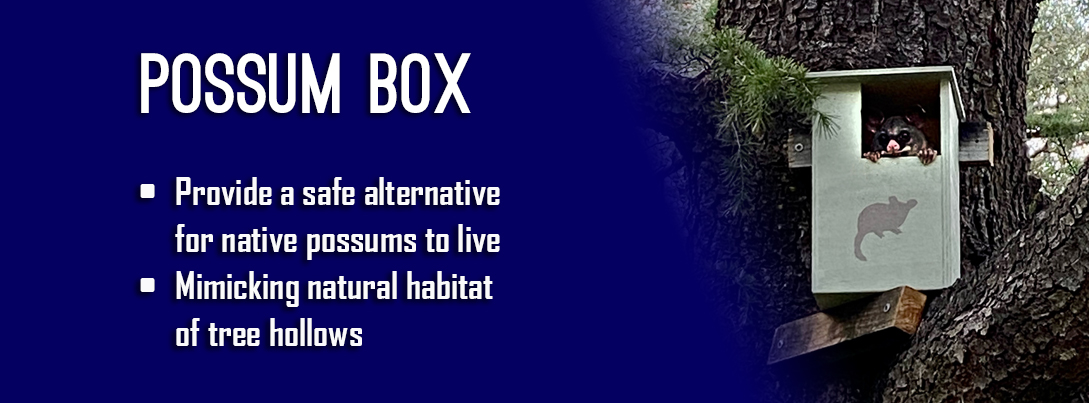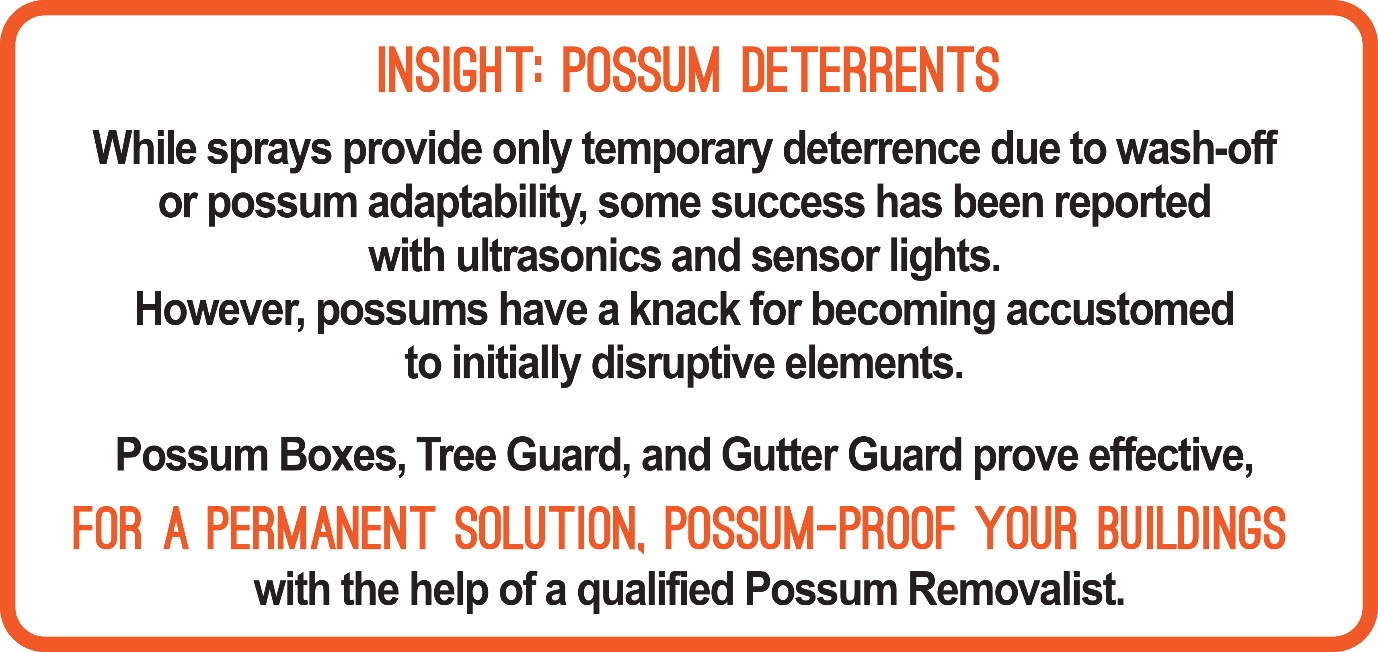
Possum deterrent vs repellents involves explore a range of products, from natural repellents to mechanical barriers and ultrasonics. We'll also delve into the benefits of alternatives like possum boxes, tree guards, and gutter protection.
Join us as we navigate through the world of possum deterrents and repellents backed by science and practical insights.
Table Of Contents:
- Possum Deterrents vs Repellents: Identifying Possum Activity
- How to Deter Possums
- Tree Guard: How it Works
- Gutter Guard & Valley Guard Solutions
- Possum Box: Alternative Accommodation
- Possum Deterrents vs Repellents: Do any Get the Job Done?
- Possum Deterrents vs Repellents Study: The Science Behind Repellent Efficacy
- Possum Deterrent vs Repellents Frequently Asked Questions
- Conclusion
Possum Deterrents vs Repellents: Identifying Possum Activity
Detecting possum activity on your property is the first step to effective management. Knowing what to look for can help you address issues early and prevent more significant damage.
Common Brushtail Possums and Ringtail Possums are primarily active after sundown. While you might observe their movements during the night, they also leave distinct signs during daylight hours. Common indications include overturned bins, disrupted plants or crops, droppings, and noise emanating from your roof space.
Noise in Your Roof Space
The rustling sounds of a possum moving around above your ceiling is a clear sign of an unwanted guest. You might hear scratching noises as well; these critters have sharp claws that make quite a racket when they move about. Sometimes we have even had reports of snoring!
Messy Gardens and Bins
A ransacked garden or overturned bin may point towards possum presence. They feed on fruits from fruit trees, vegetables, garden leaves and flowers and even rummage through rubbish, looking for tasty leftovers; they often leave poop under their favourite feeding spot.
Foul Smells
Possums causing a strong urine smell seeping onto your ceiling from the roof and droppings found nearby would further confirm this suspicion.
Related
- What Do Possums Eat and Possum Poop: Identifying Factors
- Possum Noises: A Guide to Species Identification
How to Deter Possums
If possums are causing havoc on your property, there's a range of lawful and effective possum deterrent methods you can use.
Note: Animal cruelty is an offence under the Prevention of Cruelty to Animals Act 1986; it is important to remember that any methods used to repel or control possums must be lawful
Using Natural Repellents
Natural possum repellents and homemade possum repellent sprays using mixtures of peppermint oil, garlic repellent spray, black treacle, cayenne pepper, hot sauce or hot English mustard are a hopeful option. These products have a lot of chatter on the internet and claim to irritate the possum's sense of taste or smell, making your garden less appealing. However, there is no evidence that these recipes work as a possum deterrent spray.
Mechanical Barriers
Tree Guard, for example, stops possums from climbing trees and accessing roofs. Another smart move is using Gutter Guard & Valley Guard. It denies roof access to not just possums but rats and snakes, too.
Ultrasonic Possum Deterrents: Are They Worth the Buzz?
You might wonder if ultrasonic possum deterrents are as impressive as they sound. The theory is that these devices emit high-frequency noises, unnoticeable to human ears but annoying enough for possums to steer clear of your property.
An important point you need to consider - the possum adaptability. These animals are known for their remarkable ability to become accustomed or 'immune' over time, even to things initially disturbing them.
Ultrasonics may work temporarily, but its efficacy diminishes because possums just get used to the noise.
Lights to Deter Possums?
Motion sensor lights operate by identifying movement in their immediate vicinity and reacting with a burst of bright light. The most prevalent types of this technology are passive and active infrared systems.
Passive sensors identify heat signatures from moving objects, while active sensors release an infrared signal, measuring the reflection to discern any motion.
Studies have suggested that high-intensity light can be disconcerting for many nocturnal creatures like possums due to their sensitive eyesight.
Employing sensor lights could help discourage these unwelcome visitors, but only until they get used to them.
Related
- Possum: Proven Deterrent and Removal Methods
- Possum Removal: How to Get Rid of Possums Permanently
- Possum Removalists - How to Choose the Right Expert
Tree Guard: How it Works
Tree Guards create a barrier between the trunk of the tree and those sneaky climbers. The smooth surface is hard for possum claws to grip onto, so they can't climb upwards or get into positions where they can destroy foliage.
Beyond saving your precious plants, using Tree Guard also helps keep possums away from rooftops – often used as entry points by these animals into homes and other buildings - preventing access via trees drastically reduces rooftop invasions.

Related
Gutter Guard & Valley Guard Solutions
Gutter & Valley Guard are an effective barrier against critters climbing into your roof space. This ingenious device fits into your gutters, preventing access by pests while still allowing rainwater to flow freely.
The key here lies in its design; small holes let water through but are too tiny for possums or rats to squeeze themselves into.
This clever approach does more than keep out unwanted guests. By blocking entry points, you're safeguarding your home from potential damage caused by these creatures who love bundling up your insulation for a cosy bed during the day.
Beyond just deterring pests, gutter & valley guards also have another surprising benefit: they prevent debris build-up, which could lead to blocked drains or fire hazards during drier months.
So if you want peace of mind (and quieter nights), this may well be the investment you need.

Related
Possum Box: Alternative Accommodation
If you're at the end of your tether with possums in your roof, why not consider a possum box as an alternative? This handy solution can provide our furry friends with a cosy home without them needing to resort to nesting inside your ceiling cavity.
A possum box is a wooden house for possums designed specifically for their needs. The boxes mimic the natural tree hollows that they prefer.
But remember, this isn't just about slapping any old crate onto a branch and hoping for the best. Correct installation and design of these boxes is crucial if we want them to serve as effective deterrents against roof invasion.
- The height should be around 4 metres from ground level so predators can't reach easily.
- The entrance hole size matters, too; it must accommodate the body size of local species but prevent larger animals from intruding.
- You'll need some foliage cover as well; naked trees aren’t inviting for shy critters like these.
Installing correctly placed and sized nesting boxes not only provides homes away from human dwellings but also helps preserve wildlife populations by replacing lost habitats due to deforestation or urban development.

Related
Possum Deterrents vs Repellents: Do any Get the Job Done?
Possums can be a real pain, but do possum repellents really work? It's not as straightforward as you might think. Some repellents target the smell and taste senses of these animals, while others focus on texture.
The effectiveness of any of these compounds is not proven, but if you would like to conduct your own experiments before calling a Possum Removalist, here is a list of the more common options and how they work or so they say. The letters (S), (T) or (F) after the products indicate if they are intended to repel by smell (S), taste (T) or feel (F).
Charlie Carp® (S) (fish-based fertiliser): spray/paint on plant stems or other parts to be protected.
Skunk-off® (S) (proprietary repellent product): follow label instructions.
Tea-based deterrent (T): boil two litres of water; add four heaped tablespoons of Lapsang Souchong tea; leave to cool, strain off the liquid and apply from a plastic spray bottle directly onto affected plants. Reapply every two weeks and always after rain. Make a fresh brew every time.
Indonesian fish sauce (T): place one tablespoon of sauce in one litre of water and spray on foliage.
Garlic spray (S, T): place two tablespoons of freshly crushed garlic (a variation is to add two tablespoons of freshly crushed hot chilli) in one litre of hot water. Allow to stand overnight. Spray on foliage.
Quassia bark chips (T) (Chips of bark from a South American tree): add 100 g chips to 2 litres of water and heat for one hour before straining. Add one tablespoon of detergent. Dilute at a rate of 1 part of the solution to four parts water and apply as a spray.
Blood & Bone (S) (Animal-derived fertiliser): sprinkle around the base of plants to be protected.
D-ter® (S, T) (proprietary repellent product): follow label instructions.
Keep Off® (S) (proprietary repellent product): follow label instructions.
Stay Off® (S) (proprietary repellent product): follow label instructions.
Scat® (S) (proprietary repellent product): follow label instructions.
Tabasco Sauce® (T): use full strength as paint or spray.
Possum Deterrents vs Repellents Study: The Science Behind Repellent Efficacy
A study conducted by Deakin University in Melbourne, tested fourteen products commonly used as deterrents for their efficacy.
This study involved one particular population of possums at a single site. The products tested were Garlic spray, Tabasco sauce®, Hot English mustard, Indonesian fish sauce, White King®, Camphor, Naphthalene flakes, Quassia chips, Blood and Bone, Keep Off®, Stay Off®, D-Ter®, Scat® and Bitrex®.
Various possum repellents, including commonly available products found in supermarkets or plant nurseries, were assessed in this study. One exception was Bitrex, a bittering agent used to make certain products unpalatable in proprietary repellent products like D-Ter®.
These products were categorised based on their supposed repellency method—either by taste (gustatory repellents) or odour (olfactory repellents). Tests were designed specifically for each category, although two products, garlic spray and D-Ter®, were evaluated for taste and odour repellency.
Gustatory repellents were tested using grids of apple pieces, comparing untreated and treated samples over two-hour trials with wild possums accessing the food. The study recorded possum behaviour and the amount of food remaining in each treatment at the end of the trial period.
The study observed that hungry possums consumed all provided apples regardless of the repellents used. Various products like Tabasco sauce, hot English mustard, Indonesian fish sauce, Bitrex, garlic spray, and D-Ter were tested.
In olfactory trials, attempts to access treated apples were fewer than untreated ones, indicating potential repellency for products like Keep Off® and Scat®. However, it's important to note that the results may not be universally applicable to possums in different environments or in other types of tests.
Reference: Cooney, Janine 1998. An evaluation of commonly used deterrents for urban common brushtail possums, Trichosurus vulpecula (Kerr, 1792). BSc (Hons) thesis, School of Ecology and Environment, Deakin University.

Possum Deterrents vs Repellents Frequently Asked Questions
What do possums hate most?
Possums dislike pungent smells, bright lights, and loud noises. They're not fans of ammonia, mothballs, or garlic, either. But are very adaptive, so will get used to anything you try soon enough.
What home remedy keeps possums away?
A mix of chilli pepper, onion, and garlic blended is mentioned on many websites and home and garden forums it is said to act as a homemade deterrent. Spray this around your property to keep the critters at bay. Although it won't deter them for long, it will wash off, or they will get used to the smell; nothing works if they are hungry enough.
What is the fastest way to get rid of a possum?
Hire a licensed professional for advice on how to remove a possum legally. Otherwise, use humane traps with bait like fruits or vegetables if you prefer DIY methods. However, this will require you to get a licence from National Parks and Wildlife.
Possums must be released no more than 25-150 meters, and they are more than likely to return. Attempting anything beyond this range would be considered illegal.
Does eucalyptus oil deter possums?
No concrete evidence shows that eucalyptus oil works against possums. People might think it will help due to its strong smell, which these animals typically avoid. However, Eucalyptus leaves are one of their main food sources so it potentially attracts them instead.
What is the best possum deterrent?
The best deterrents are physical barriers such as Tree Guard, Valley Guard and Gutter Guard.
Does Vicks Vaporub deter possums?
Anecdotal evidence suggests this is effective in the short term, and it won't wash off if you mix it with Vaseline. Possums are known to get used to smells, though, so it might not be a long-term solution.
What smells do Australian possums hate?
Anything strong smelling will annoy Possums but not enough to leave your garden forever.
How do you get rid of possums permanently?
The only way to guarantee possums are gone permanently is to possum-proof your buildings; a qualified Possum pest control professional will help you.
Conclusion
Possum deterrents vs repellents is controversial. In your quest to manage possums, identifying their activity is crucial. Whether it's the distinctive noises in your roof space, messy gardens, or unpleasant odours, recognizing these signs empower you to take action.
When it comes to deterrence, a multi-pronged approach is key. Providing alternative homes with possum boxes and safeguarding trees with tree guards can redirect possums away from your roof.
For those seeking a comprehensive solution, gutter guard installation ensures possums, rats, and snakes have no access to your roof, offering peace of mind for homeowners.
While possum deterrents and repellents do exist, it's essential to consider their application and efficacy. By understanding the science behind repellent efficacy, you can make informed decisions about the best possum deterrents for your unique situation.
With these insights and strategies, you're equipped to take charge and create a possum-free environment in your home.

More Possum articles you may like:
- Possum Trap: Essential Do’s and Don’ts for Success
- Dead Possum Dilemma: Removal and Prevention
- Catch and Release Licences: How to Remove Possums Legally
More Rat articles you may like:
- Rat Bait: Navigating Successful Pest Management
- How to Get Rid of Rats: Rodent Control Strategies that Work
- Rat Traps: The Ultimate Guide to Bait Free Rodent Control
- Rat Identification: Signs of Rodent Activity







